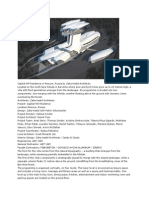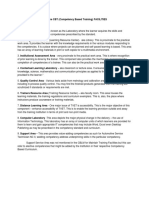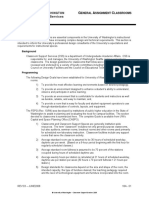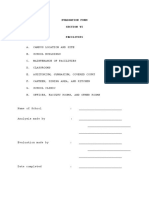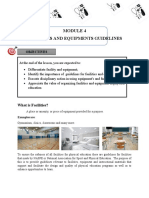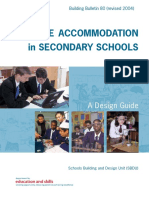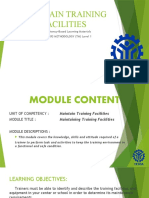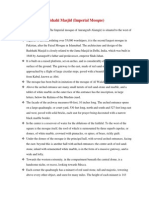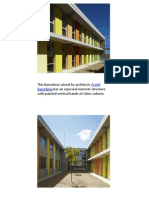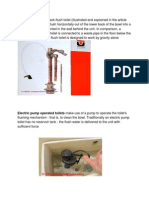Spac G Fa Ep Guid Devel Acilitie Octob Plan Delin Loped Es Ser Ber 20 Nni Nes Dby Rvices 009 Ing S S Space 1
Uploaded by
Siva RamanSpac G Fa Ep Guid Devel Acilitie Octob Plan Delin Loped Es Ser Ber 20 Nni Nes Dby Rvices 009 Ing S S Space 1
Uploaded by
Siva RamanSpac G Fa eP Guid Devel acilitie Octob Plan delin loped es Ser ber 20 nni nes d by rvices 009 ing
s s Space 1
2 TABLE OF CONTENTS Introduction. 3 I. 100 Classroom Facilities. 100-4 through 100-5 II. 200 Laboratory Facilities.... 200-6 through 100-12 III. 300 Office Facilities... 300-13 through 100-14 IV. 400 Library/Study Facilities. .......... 400-15 through 100-15 V. 500 Special Use Facilities.. 500-16 through 500-16 VI. 600 General Use Facilities.. 600-17 through 600-17 VII. 700 Support Facilities..700-18 through 700-18 VIII. 800 Health Care Facilities.. 800-19 through 800-19 IX. 900 Residential Facilities.... 900-20 through 900-20 X. 000 Unclassified Facilities.. 000-21 through 000-21 XI. Appendix.22-24 Space 3 Introduction The intention of the Space Planning Guidelines is to regard space allocation more judiciously, to ensure that new construction is planned realistically, efficiently, carefully and conservatively, and to promote optimum use and conservation of space in existing and renovated buildings. It is also important for these guidelines to remain flexible for the needs of Idaho State University in the future. The following guidelines have been developed by ISU Facilities Services to serve as an aid in the planning, allocating and managing of space for the University. They are intended to assist in establishing fair, reasonable, consistent, efficient and flexible planning parameters as well as making sound management decisions about space allocations both for new building spaces and within existing or renovated buildings.
This planning guideline is modeled after other universities, as a work in progress (Stanford University, Auburn University, Oregon State University, UNLV, University of Oklahoma, Austin Community College and State of Washington Universities and Colleges). This planning guide also references the Postsecondary Education Facilities Inventory and Classification Manual (FICM): 2006 Edition classification names and numbers and the State of Idaho Comprehensive Policy on Space and Facilities Executive order No. 2001-08. These Space Planning Guidelines will continue to be reviewed and adapted to truly represent the universitys space needs based upon factors (economics, needs, direction, etc.), for new and existing campus buildings for the University.
4 100 Classroom Facilities I. This category aggregates classroom facilities as an institution-wide resource, even though these areas may fall under different levels of organizational control. The term classroom includes not only general purpose classrooms, but also lecture halls, recitation rooms, seminar rooms and other spaces used primarily for scheduled non-laboratory instruction. Total classroom facilities include any support rooms that serve the classroom activity (e.g., Codes 110 and 115 as defined below). 110 Classroom Definition: A room or space used primarily for instruction classes and which is not tied to a specific subject or discipline by equipment in the room or the configuration of the space.
Description: Includes rooms or spaces generally used for scheduled instruction which require no special, restrictive equipment or configuration. These spaces may be called lecture-demonstration rooms, seminar rooms, and general purpose classrooms. A classroom may be equipped with tablet arm chairs, table and chairs, or similar type of seating. These spaces may contain multimedia or telecommunications equipment. A classroom may be furnished with special equipment (e.g., globes, pianos, maps, computers, network connections) appropriate to a specific area of study, if this equipment does not render the space unsuitable for use by classes in other areas of study. 115 Classroom Service Definition: A space that directly serves one or more classrooms as an extension of the activities in that space. Description: Includes projection rooms, Audio/Video rooms, telecommunications control booths, preparation rooms, coat rooms, closets, storage areas, etc., if they serve classrooms. This space category of Classroom Service requires an analysis of what the classroom use will be, whether general or specific use, and therefore may require different sizes of classroom service. Therefore, Classroom service will therefore need to be determined at the time of planning and coordination with specific academic departments. Space 5 Design Standards for Classroom Space Types ROOM CATEGORY ROOM STUDENT CAPACITY
MOVABLE CHAIR W/TABLET ARM (nasf)* AUDITORIUM SEATING (nasf)* MOVABLE TABLE AND CHAIRS (nasf)* FIXED TABLE W/ MOVABLE CHAIR (nasf)* Seminar/Small Classroom 0-25 17-24 -- 16-26 20-22 Medium Classroom 26-49** 16-18 -- 16-26 18-20 Large
Classroom 50-99 14-16 14-17 16-22 18-20 Lecture Halls 100-149 150-299 300+ ---12-15 10-14 10-14 16-22 16-22 16-22 18-20 17-19 16-18 Figure 100-A Notes: 1. The table above is a guideline for new construction ormajorrenovationsto insure the appropriate amount of space perseat/student. Actualspace perseat/studentmay vary depending on existing roomconfiguration as well astype offurniture and seating used. All classrooms of a 50+ capacity requires additional considerations
and review on a case by case basis. 2. *NASFDefinition: The sumof all areas on allfloors of a building assigned to, or available for assignmentto, an occupant orspecific use. Can also be defined asindividualspace within a floor/building thatis assignable. 3. **Seating capacity perfire codesformost classrooms with only one entrance/exit doorshould not exceed a student/instructor capacity of 49.
6 200 Laboratory Facilities II. A laboratory is a facility characterized by special purpose equipment or a specific space configuration that limits instructional or research activities to a particular discipline or a closely related group of disciplines. These activities may be individual or group in nature, with or without supervision. Laboratories may be found in all fields of study including letters, humanities, natural sciences, social sciences, vocational and technical disciplines, etc. The nature of laboratory experiences has changed in many disciplines with the introduction of computer simulation in combination with, or as replacement of, the old wet lab experience in both natural and social sciences. Curricular intent should be considered as well as the physical structure of the space. Laboratory facilities can be subdivided into three categories: class, open, and research/non-class laboratory. A Class Laboratory is used for scheduled instruction. An Open Laboratory supports instruction but is not formally scheduled. A Research/non-class Laboratory is used for research, experimentation, observation, research training, or structured creative activity that supports
extension of a field of knowledge. Institutions may wish to further distinguish various types of Class, Open, and Research/non-class laboratories through the use of extension or special codes. 210 Class Laboratory Definition: A space used primarily for formally or regularly scheduled instruction (including associated mandatory, but non-credit-earning laboratories) that require special purpose equipment or a specific space configuration for student participation, experimentation, observation, or practice in an academic discipline. A space is considered to be scheduled if the activities generate weekly student contact hours (WSCHs), the activities fulfill course requirements, and/or there is a formal convener present. Description: A Class Laboratory is designed for or furnished with equipment to serve the needs of a particular discipline for group instruction in formally or regularly scheduled classes. This special equipment normally limits or precludes the use of the spaces, by other disciplines. Included in this category are spaces generally called teaching laboratories, instructional shops, computer laboratories, drafting rooms, band rooms, choral rooms, (group) music practice rooms, language laboratories, (group) studios, theater stage areas used primarily for instruction, instructional health laboratories, and similar specially designed or equipped rooms, if they are used primarily for group instruction in formally or regularly scheduled classes. Computer rooms used primarily to instruct students in the use of computers are classified as Class Laboratories if that instruction is conducted primarily in formally or regularly scheduled classes. Space 7 215 Class Laboratory Service Definition: A space that directly serves one or more Class Laboratories as an extension of the activities in those spaces.
Components:* Total space required for class laboratory facilities is determined by considering a number of factors: Average Station Utilization and Student Contact Hours; Students; ASF per Station requirements; and Number of Stations required. A methodology for calculating total space needs for class laboratory facilities follows the brief description/definition of these factors found in the following section. 1. Station Utilization Only formally scheduled hours of instruction are included in the study of class laboratory utilization. However, laboratory classes often require blocks of preparation and dismantling times, and student make-up and extra laboratory experiment time which preclude the use of the class laboratory for scheduled instruction. Sufficient allowance for these essential nonscheduled time periods must be made when setting and analyzing class laboratory utilization rates. Class laboratories are normally not interchangeable between fields of study and utilization rates of these rooms are meaningful only when used in relationship to a single discipline. Averaging the utilization of several fields of study will result in misleading and inconclusive results. The per station utilization is calculated using standards for the average weekly hours of scheduled daytime use for class laboratories and the standard for the average room occupancy. For planning purposes, it is assumed that 20 hours of scheduled, day-time use per week constitutes full room use. It is also assumed that full occupancy is achieved when an average of 80 percent of the class laboratory stations are used per week. Average Station Utilization is thus calculated to be 16 hours, as shown below: Average Room Use x Average Room Fullness = Average Station Utilization (20 hours x 80% = 16 Hours) 2. Student Contact Hours The most basic contact hour is calculated based on one student in a class laboratory for one 50-minute period. Thus a course with 10 students that meets five times a week for 50 minutes per day is said to have 50 student contact hours (10 students x 1 - 50-minute
hour x 5 meetings). 3. ASF Per Station The ASF per station guideline numbers which follow establish an order of magnitude for class laboratory space within the major Classification of Instructional Programs (CIP) categories. (Appendix A shows square feet per station data for those specific disciplines within each major CIP group that had data. However, it is only the CIP group average that is intended to be meaningful within the arrayed data.) The guidelines are for both research and regional institutions of higher education and all levels of study (i.e., lower division, upper division and graduate course levels). The guidelines include both space classified in category 210 (Class Laboratory) and space in category 215 (Class Laboratory Service). Justification is necessary if space requirements vary significantly from the guidelines. Such justification must be supported by the curricular and/or pedagogical requirements of the discipline(s).
8 Space 9
10 220 Open Laboratory Definition: A laboratory used primarily for individual or group instruction that is informally scheduled, unscheduled, or open. Description: An Open Laboratory is designed for or furnished with equipment that serves the needs of a particular discipline or discipline group for individual or group instruction where 1) use of the space is not formally or regularly scheduled,
or 2) access is limited to specific groups of students. Included in this category are spaces generally called music practice rooms, language laboratories used for individualized instruction, studios for individualized instruction, special laboratories or learning laboratories (e.g., speech, hearing, law, psychology, and health-related professions) if discipline restricted, individual laboratories, and computer laboratories involving specialized restrictive software or where access is limited to specific categories of students. For example, a computer laboratory with only engineering or CAD software or a computer-based writing laboratory available only to English Composition students would be classified as an open laboratory because of the restricted usage of the space for a particular discipline or discipline group. Spaces containing computer equipment which are not restricted to a specific discipline or discipline group are classified as Study Rooms (410), unless the primary intent is to function as a site for structured learning or group activities rather than individual knowledge acquisition. 225 Open Laboratory Service Definition: A space that directly serves one or more open laboratories as an extension of the activities in those spaces. Assumptions:* 1. Open Class Laboratories, while often used in conjunction with Class Laboratories (210), have special and unique factors and serve an extended variety of academic functions that precludes the establishment of general planning guidelines for different disciplines or fields of study. 2. Space for new Open Class Laboratories should be determined based on the specific course curriculum and pedagogy, number of students to be served by the open class laboratory, and support space required. For planning purposes, the number of open class laboratories and the number of stations in each laboratory should be based on extensive and in-depth consultations
with individual faculty teaching the courses that will use the open class laboratories, administrative personnel, institutional architects and project managers and professional laboratory planning consultants. 3. Total space required for open laboratory facilities is determined by factoring in ASF per Station and Number of Stations requirements. Average Station Utilization and Student Contact Hours cannot be derived due to the informal and unscheduled use of the facility. Space 11 250 Research/Non-class Laboratory Definition: A space used for laboratory experimentation, research, or training in research methods; professional research and observation; structured creative activity within a specific program, for sponsored research (whether sponsored with federal, state, private, or institutional funds). Description: A Research/non-class Laboratory is designed or equipped for faculty, staff, and students for the conduct of research and controlled or structured creative activities. These activities are generally confined to faculty, staff, and assigned graduate students and are applicable to any academic discipline. Activities may include experimentation, application, observation, composition, or research training in a structured environment directed by one or more faculty or principal investigators. These activities do not include practice or independent study projects and activities that, although delivering new knowledge to a student, are not intended for a broader academic (or sponsoring) community (e.g., a presentation or publication). This category includes laboratories that are used for experiments, testing, or dry runs in support of instructional, research, or public service activities. Non-class public service laboratories that promote new knowledge in academic fields (e.g., animal diagnostic laboratories, cooperative extension laboratories) are included in this category.
255 Research/Non-class Laboratory Service Definition: A space that directly serves one or more research/non-class laboratories as an extension of the activities in those spaces.
12 Assumptions:* 1. Research laboratories have special and unique factors and serve an extended variety of research functions that preclude the establishment of general planning guidelines for different disciplines or fields of study. 2. Space for new research laboratories should be determined based on the specific research and support space requirements for the different disciplines or fields of study. For planning purposes, the number of research laboratories and the special attributes found in each laboratory should be based on extensive and in-depth consultations with individual faculty using the laboratories, administrative personnel, institutional architects and project managers and professional laboratory planning consultants.. 3. At a minimum, research laboratory facilities should be planned and designed to: Provide Flexibility: building expansion capability, ability to convert space from one activity to another, ability to adapt to changing and new technologies and procedures. Enhance Communication: communication through spatial requirements, understanding the role of communication in accomplishing research. Ensure Safety: code compliance/regulatory guidelines, fire and environmental hazards, personal security. Provide Adequate Building Systems: structural, mechanical, electrical, communication. 4. Planning of research laboratories should be based on a modular concept that provides
flexibility, ensures safety and environmental conditions, promotes communication and maintains project cost controls. There is no single planning module that will satisfy all research laboratory needs. Data from modules used in other facilities, while providing valuable comparisons, should not be used without validation testing to see how they would accommodate the specific needs of the current research laboratory project. Factors that affect designs are:* a. Number of people to be accommodated in the space. b. Modes of communication and traffic patterns. c. Number and type of work and research spaces. d. Special equipment and building design features. e. Future trends in the field. f. Special support systems and controls required for the research. g. Overall building construction methods. Space Formula: Research facilities are provided as program funding permits. *Reference: Facilities Evaluation and PlanningGuideRevised by the Interinstitutional Committee of SpaceOfficersrepresenting the public fouryear colleges and universitiesin the state of Washington (1994) Space 13 300 Office Facilities III. Office facilities are individual, multi-person, or workstation spaces specifically assigned to executive, academic, administrative, and service functions of Idaho State University. Office space will have a classification space use code of Office (310), and the additional differentiation for the appropriate Idaho State University division and department. 310 Office Definition: A space housing faculty, staff, or students working at one or more
desks, tables, or workstations. Description: An Office is typically assigned to one or more persons as a station or work area. It may be equipped with desks, chairs, tables, bookcases, filing cabinets, computer workstations, microcomputers, or other office equipment. Included are executive, faculty, administrative, clerical, graduate assistant, and teaching assistant, and student offices. Design Standards for Office Space Types Office Facilities (310) NASF Dean and Equivalent 200 Min. Chairs, Directors, Dept. Head and Equivalent 150 Min. Faculty/Professional/Sr. Staff and Equivalent 120 Min. Student Assistants 100 (See Note #3) Administrative Assistant, Office Specialist, 100 Secretarial, Clerical Staff and Others 80 Cubicles 50 315 Office Service
14 Definition: A space that directly serves an office or group of offices as an extension of the activities in those spaces. Description: Includes file rooms, break rooms kitchenettes serving office areas, copy and fax rooms vaults, closets private rest rooms not available to the public,
records rooms, office supply rooms, first aid rooms serving office areas, student counseling rooms, testing (assessment, non-health, non-discipline-related) rooms, and open or private (restricted/nonpublic) circulation areas. Office Services (315) Percentage of Total Dept. NASF Office Service 5% Waiting/Reception Room 5% Office Server Room 80 nasf (def. page 5) 350 Conference Room Definition: A space serving an office complex and used primarily for staff meetings and departmental activities. 355 Conference Room Service Definition: A space that directly serves one or more conference spaces as an extension of the activities in those spaces. Conference Room/Service (350 & 355) NASF per FTE 8 or Less FTE Chair Office Use 8 to 25 FTE 20 Over 25 Classroom Use Notes/Assumptions: 1) Space requirements perfulltime equivalent(FTE). 2) FTEs are one ofthe keymetricsformeasuring the contribution of academicsin third level education. Academics in some universities are nominally expected to contribute 20 FTEsin any one year. Thisistypically achieved through a combination ofteaching and research supervision. 3) The net assignable square feet(NASF) numberslisted above are average numbers. Some projectsmay require more orlessspace than these averages.
4) Assumes aminimumoftwo staffmembers per office space. 400 Space 15 Study Facilities IV. Library and Study space is classified into five categories: Study Room (library or nonlibrary), Stack, Open-Stack Study room, Processing Room (user assistance or technical processing), and Study Service. Offices used for library activities are coded as Office facilities. A study space may contain equipment or materials that aid the study or learning process (e.g., computers, multimedia carrels, CD and DVD players, typewriters, records and tapes) and does not restrict the space to a particular academic discipline or discipline group. Whereas a Study Room (410) may appear in almost any type of building on campus (e.g., academic, residential, student service), Stacks (420), Open-Stack Study Rooms (430), and Processing Rooms (440) are typically located in central, branch, and departmental libraries. Identification of library space should be made through the use of functional categories, and departmental space through the combined use of academic discipline and functional categories. 410 Study Room. 420 Stack. 430 Open-Stack Study Room. 440 Processing Room. 455 Study Service. 500
You might also like
- Hourglass Workout Program by Luisagiuliet 276% (21)Hourglass Workout Program by Luisagiuliet 251 pages
- Read People Like A Book by Patrick King-Edited61% (69)Read People Like A Book by Patrick King-Edited12 pages
- Livingood, Blake - Livingood Daily Your 21-Day Guide To Experience Real Health77% (13)Livingood, Blake - Livingood Daily Your 21-Day Guide To Experience Real Health260 pages
- Donald Trump & Jeffrey Epstein Rape Lawsuit and Affidavits83% (1016)Donald Trump & Jeffrey Epstein Rape Lawsuit and Affidavits13 pages
- The 36 Questions That Lead To Love - The New York Times94% (34)The 36 Questions That Lead To Love - The New York Times3 pages
- The 36 Questions That Lead To Love - The New York Times95% (21)The 36 Questions That Lead To Love - The New York Times3 pages
- Jeffrey Epstein39s Little Black Book Unredacted PDF75% (12)Jeffrey Epstein39s Little Black Book Unredacted PDF95 pages
- The 4 Hour Workweek, Expanded and Updated by Timothy Ferriss - Excerpt23% (954)The 4 Hour Workweek, Expanded and Updated by Timothy Ferriss - Excerpt38 pages
- Zimbabwe School Examinations Council: PAPER 3 Practical TestNo ratings yetZimbabwe School Examinations Council: PAPER 3 Practical Test4 pages
- S Spac G Cep Guid Plan Delin Nni Nes Ing S: Fa Devel Acilitie Octob Loped Es Ser Ber 20 Dby Rvices 009 SNo ratings yetS Spac G Cep Guid Plan Delin Nni Nes Ing S: Fa Devel Acilitie Octob Loped Es Ser Ber 20 Dby Rvices 009 S22 pages
- Training Facilities Preparation ProcedureNo ratings yetTraining Facilities Preparation Procedure5 pages
- The Nine CBT (Competency Based Training) FACILITIESNo ratings yetThe Nine CBT (Competency Based Training) FACILITIES1 page
- Annex 6 3 Sample Observation Checklist School Facilities Infrastructure 0No ratings yetAnnex 6 3 Sample Observation Checklist School Facilities Infrastructure 08 pages
- 0 0 Briefing Document Avalon Block ResearchNo ratings yet0 0 Briefing Document Avalon Block Research14 pages
- Aviation Acadamy Litreture Review, Case StudyNo ratings yetAviation Acadamy Litreture Review, Case Study25 pages
- U W G A C: Classroom Support Services Design GuideNo ratings yetU W G A C: Classroom Support Services Design Guide22 pages
- Laboratories 93. Infrastructure Available in The LabsNo ratings yetLaboratories 93. Infrastructure Available in The Labs3 pages
- Aicte Norms For Infrastructure of Engineering and Technology Institutes GeneralNo ratings yetAicte Norms For Infrastructure of Engineering and Technology Institutes General15 pages
- Cleaning - Space Types: Space No. Space Type Archibus Primary Room Type Space DescriptionNo ratings yetCleaning - Space Types: Space No. Space Type Archibus Primary Room Type Space Description7 pages
- Vi - Facilities Physical Plant Evaluation FormNo ratings yetVi - Facilities Physical Plant Evaluation Form20 pages
- Facilities and Equipments Guidelines: ObjectivesNo ratings yetFacilities and Equipments Guidelines: Objectives7 pages
- Research Laboratory - WBDG Whole Building Design GuideNo ratings yetResearch Laboratory - WBDG Whole Building Design Guide7 pages
- Building Bulletin 80 - Science AccommodationNo ratings yetBuilding Bulletin 80 - Science Accommodation54 pages
- Activity 1 in School Plant 1st-Sem-2020-2021No ratings yetActivity 1 in School Plant 1st-Sem-2020-20215 pages
- Maintain Training Facilities: Competency-Based Learning Materials Trainers Methodology (TM) Level 1No ratings yetMaintain Training Facilities: Competency-Based Learning Materials Trainers Methodology (TM) Level 14 pages
- 10 - Medical College Facilities Tour Upto 100No ratings yet10 - Medical College Facilities Tour Upto 1005 pages
- Career and Technical Education 24 Feb 12No ratings yetCareer and Technical Education 24 Feb 128 pages
- For Your Architectural Literature Review On Campus Design100% (1)For Your Architectural Literature Review On Campus Design8 pages
- All India Council For Technical Education - Norms & StandardNo ratings yetAll India Council For Technical Education - Norms & Standard21 pages
- Estate Management and Valuation (Assignment) Carpish EstNo ratings yetEstate Management and Valuation (Assignment) Carpish Est7 pages
- 4.1.1 What Is The Policy of The Institution For Creation and Enhancement of Infrastructure That Facilitate Effective Teaching and Learning?No ratings yet4.1.1 What Is The Policy of The Institution For Creation and Enhancement of Infrastructure That Facilitate Effective Teaching and Learning?9 pages
- Seuxcftfef?: 29.1 Laboratory InstructionsNo ratings yetSeuxcftfef?: 29.1 Laboratory Instructions4 pages
- Norms FOR Infrastructure Norms For InfrastructureNo ratings yetNorms FOR Infrastructure Norms For Infrastructure8 pages
- Introduction to Educational Facilities for Education(ED206)ReportNo ratings yetIntroduction to Educational Facilities for Education(ED206)Report141 pages
- Intro To Computer Programming Assignment 2No ratings yetIntro To Computer Programming Assignment 24 pages
- Guidelines Develeopment Skills Labs MedicalCollegesNo ratings yetGuidelines Develeopment Skills Labs MedicalColleges2 pages
- A Proposal To Develop Faculty LaboratoriesNo ratings yetA Proposal To Develop Faculty Laboratories5 pages
- A Trainer’S Guide for Preclinical Courses in Medicine: Series I Introduction to MedicineFrom EverandA Trainer’S Guide for Preclinical Courses in Medicine: Series I Introduction to MedicineNo ratings yet
- Human Factors and Ergonomics and Anthropometrics100% (3)Human Factors and Ergonomics and Anthropometrics26 pages
- Arameters of Sustainable Design and Development in Urban Development and Community Planning AnalysisNo ratings yetArameters of Sustainable Design and Development in Urban Development and Community Planning Analysis6 pages
- Historic Reinterpretation and Conservation of Srirangam Town100% (2)Historic Reinterpretation and Conservation of Srirangam Town13 pages
- Sri Renugamabal College of Architecture, Polur: Answer ALL QuestionsNo ratings yetSri Renugamabal College of Architecture, Polur: Answer ALL Questions2 pages
- Sriganesh Rajendran 11:17 PM: Posted by atNo ratings yetSriganesh Rajendran 11:17 PM: Posted by at1 page
- Sri Renugamabal College of Architecture, Polur: Answer ALL QuestionsNo ratings yetSri Renugamabal College of Architecture, Polur: Answer ALL Questions2 pages
- This Barcelona School by Architects Has An Exposed Concrete Structure With Painted Vertical Bands of Citrus ColoursNo ratings yetThis Barcelona School by Architects Has An Exposed Concrete Structure With Painted Vertical Bands of Citrus Colours5 pages
- Revised Sterilization Methods and Principles PDF100% (1)Revised Sterilization Methods and Principles PDF21 pages
- Back-Flush Toilet: A Back-Flush Toilet (Illustrated and Explained in The ArticleNo ratings yetBack-Flush Toilet: A Back-Flush Toilet (Illustrated and Explained in The Article9 pages
- GCSE Drama Written Exam: Time Allowed InstructionsNo ratings yetGCSE Drama Written Exam: Time Allowed Instructions4 pages
- 8 Activities For Formative Assessment-2 - 111018No ratings yet8 Activities For Formative Assessment-2 - 11101858 pages
- Livingood, Blake - Livingood Daily Your 21-Day Guide To Experience Real HealthLivingood, Blake - Livingood Daily Your 21-Day Guide To Experience Real Health
- Donald Trump & Jeffrey Epstein Rape Lawsuit and AffidavitsDonald Trump & Jeffrey Epstein Rape Lawsuit and Affidavits
- The 36 Questions That Lead To Love - The New York TimesThe 36 Questions That Lead To Love - The New York Times
- The 36 Questions That Lead To Love - The New York TimesThe 36 Questions That Lead To Love - The New York Times
- Jeffrey Epstein39s Little Black Book Unredacted PDFJeffrey Epstein39s Little Black Book Unredacted PDF
- The 4 Hour Workweek, Expanded and Updated by Timothy Ferriss - ExcerptThe 4 Hour Workweek, Expanded and Updated by Timothy Ferriss - Excerpt
- Zimbabwe School Examinations Council: PAPER 3 Practical TestZimbabwe School Examinations Council: PAPER 3 Practical Test
- S Spac G Cep Guid Plan Delin Nni Nes Ing S: Fa Devel Acilitie Octob Loped Es Ser Ber 20 Dby Rvices 009 SS Spac G Cep Guid Plan Delin Nni Nes Ing S: Fa Devel Acilitie Octob Loped Es Ser Ber 20 Dby Rvices 009 S
- The Nine CBT (Competency Based Training) FACILITIESThe Nine CBT (Competency Based Training) FACILITIES
- Annex 6 3 Sample Observation Checklist School Facilities Infrastructure 0Annex 6 3 Sample Observation Checklist School Facilities Infrastructure 0
- U W G A C: Classroom Support Services Design GuideU W G A C: Classroom Support Services Design Guide
- Laboratories 93. Infrastructure Available in The LabsLaboratories 93. Infrastructure Available in The Labs
- Aicte Norms For Infrastructure of Engineering and Technology Institutes GeneralAicte Norms For Infrastructure of Engineering and Technology Institutes General
- Cleaning - Space Types: Space No. Space Type Archibus Primary Room Type Space DescriptionCleaning - Space Types: Space No. Space Type Archibus Primary Room Type Space Description
- Research Laboratory - WBDG Whole Building Design GuideResearch Laboratory - WBDG Whole Building Design Guide
- Maintain Training Facilities: Competency-Based Learning Materials Trainers Methodology (TM) Level 1Maintain Training Facilities: Competency-Based Learning Materials Trainers Methodology (TM) Level 1
- For Your Architectural Literature Review On Campus DesignFor Your Architectural Literature Review On Campus Design
- All India Council For Technical Education - Norms & StandardAll India Council For Technical Education - Norms & Standard
- Estate Management and Valuation (Assignment) Carpish EstEstate Management and Valuation (Assignment) Carpish Est
- 4.1.1 What Is The Policy of The Institution For Creation and Enhancement of Infrastructure That Facilitate Effective Teaching and Learning?4.1.1 What Is The Policy of The Institution For Creation and Enhancement of Infrastructure That Facilitate Effective Teaching and Learning?
- Introduction to Educational Facilities for Education(ED206)ReportIntroduction to Educational Facilities for Education(ED206)Report
- Guidelines Develeopment Skills Labs MedicalCollegesGuidelines Develeopment Skills Labs MedicalColleges
- A Trainer’S Guide for Preclinical Courses in Medicine: Series I Introduction to MedicineFrom EverandA Trainer’S Guide for Preclinical Courses in Medicine: Series I Introduction to Medicine
- Arameters of Sustainable Design and Development in Urban Development and Community Planning AnalysisArameters of Sustainable Design and Development in Urban Development and Community Planning Analysis
- Historic Reinterpretation and Conservation of Srirangam TownHistoric Reinterpretation and Conservation of Srirangam Town
- Sri Renugamabal College of Architecture, Polur: Answer ALL QuestionsSri Renugamabal College of Architecture, Polur: Answer ALL Questions
- Sri Renugamabal College of Architecture, Polur: Answer ALL QuestionsSri Renugamabal College of Architecture, Polur: Answer ALL Questions
- This Barcelona School by Architects Has An Exposed Concrete Structure With Painted Vertical Bands of Citrus ColoursThis Barcelona School by Architects Has An Exposed Concrete Structure With Painted Vertical Bands of Citrus Colours
- Back-Flush Toilet: A Back-Flush Toilet (Illustrated and Explained in The ArticleBack-Flush Toilet: A Back-Flush Toilet (Illustrated and Explained in The Article
- GCSE Drama Written Exam: Time Allowed InstructionsGCSE Drama Written Exam: Time Allowed Instructions






























